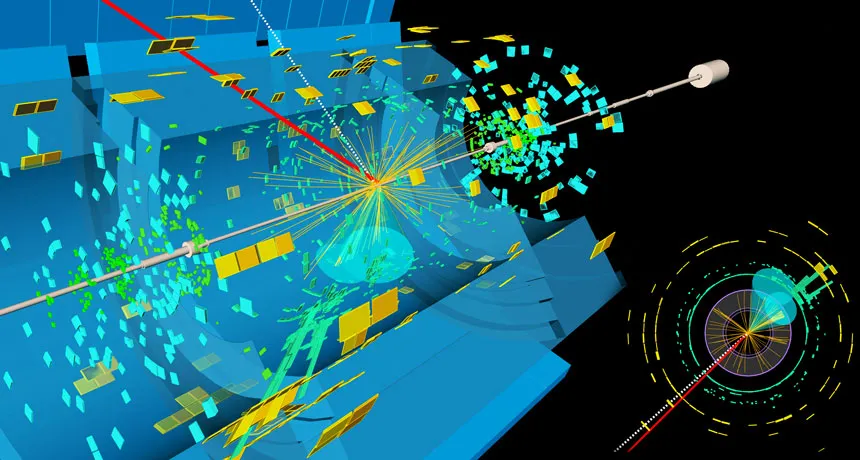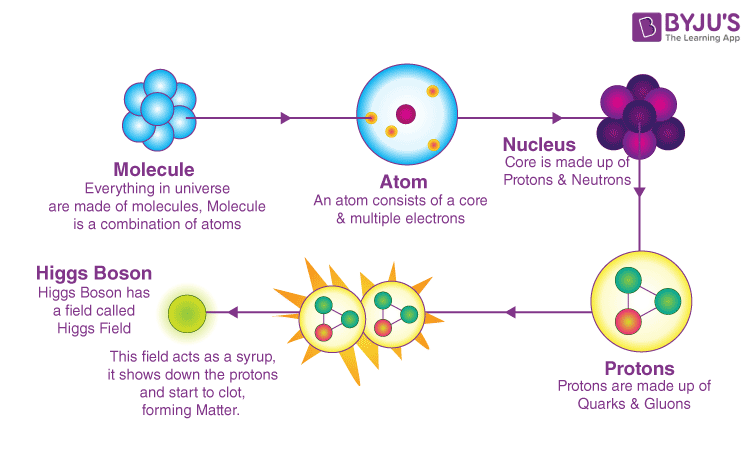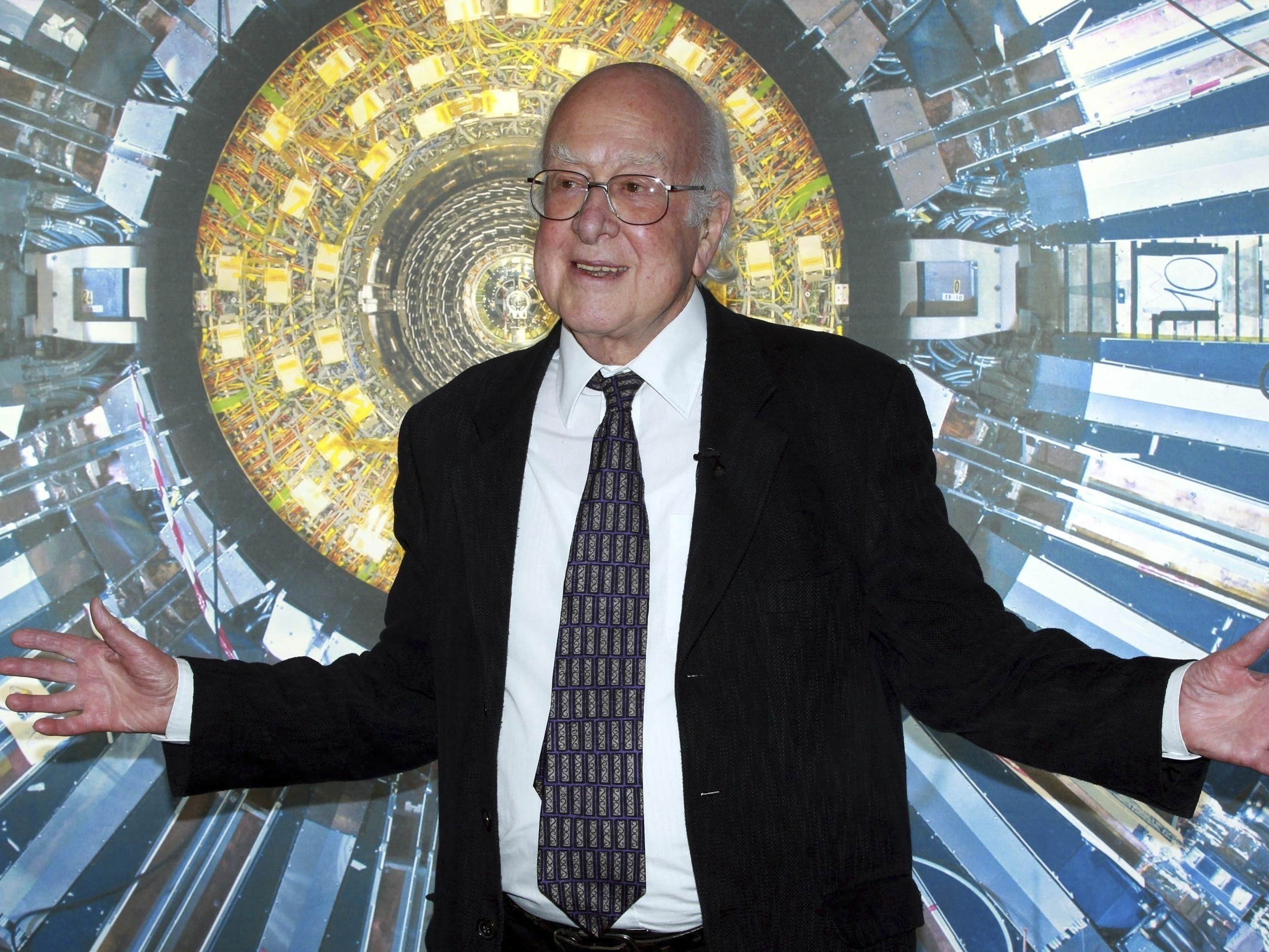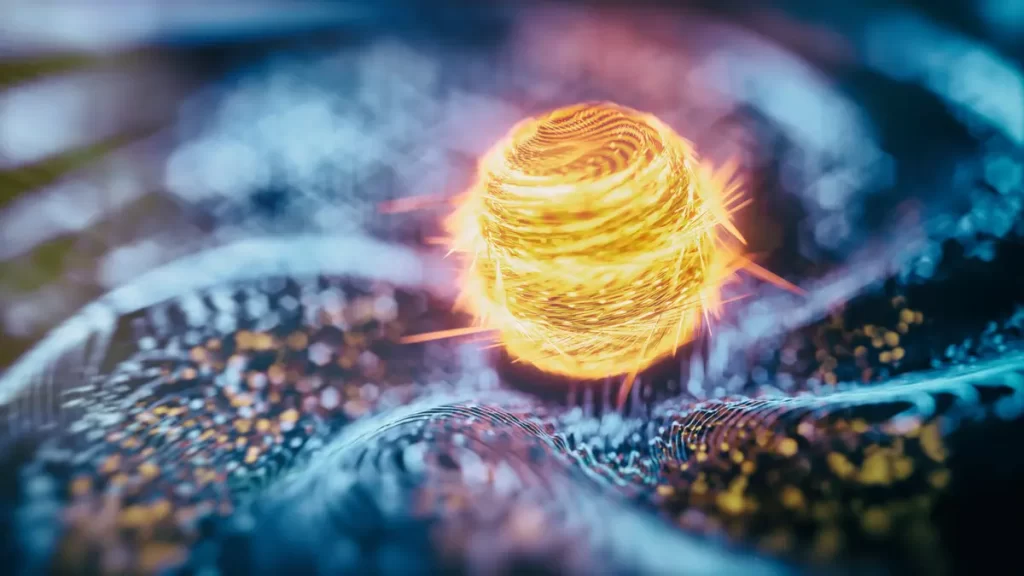Table of Contents
A Fundamental Key to the Universe
Often called the “God Particle,” this elusive component is essential in explaining why matter has mass. It was first proposed in the 1960s as part of the Standard Model, which describes the fundamental forces shaping the universe. Without it, elementary particles like quarks and electrons would remain massless, preventing the formation of atoms, molecules, and ultimately, life. The search for this particle lasted nearly 50 years, requiring advanced technology to detect it. In 2012, the Large Hadron Collider (LHC) at CERN provided the long-awaited confirmation. Its discovery validated the Standard Model and deepened our understanding of the physical universe, cementing the Higgs boson as one of the most groundbreaking findings in modern science.
Despite this major breakthrough, mysteries remain about its exact role in the universe. Scientists continue to investigate whether it interacts with dark matter or if additional types of Higgs-like particles exist. The LHC continues colliding protons at near-light speeds to generate new data, and future experiments aim to refine measurements of the particle’s properties. Understanding its precise behavior may help answer fundamental questions about the early universe and the unification of forces. The discovery of the Higgs boson was just the beginning—its full implications are still unfolding, promising deeper insights into the building blocks of reality.
The Birth of a Groundbreaking Theory
In 1964, multiple physicists independently proposed a solution to one of the biggest mysteries in physics: why do particles have mass? Peter Higgs, François Englert, and Robert Brout, along with Gerald Guralnik, Carl Hagen, and Tom Kibble, introduced the idea of an invisible energy field spread throughout the universe. This theoretical construct, now called the Higgs field, would allow certain particles to acquire mass by interacting with it, while others would remain unaffected. The existence of this field was crucial to explaining how the universe took shape. Without it, elementary particles would move at the speed of light, preventing the formation of atoms. The Higgs boson was predicted as the key evidence needed to confirm this field’s existence.
For decades, this theory remained unproven because no experiment could directly test its validity. The challenge lay in detecting an invisible, all-pervasive field and identifying the unique particle associated with it. The search required energies far beyond what was available at the time. In the following years, the idea of spontaneous symmetry breaking gained traction in particle physics, influencing the development of the Standard Model. However, skepticism remained, as many scientists questioned whether the Higgs boson could ever be found. It would take nearly half a century, along with the most powerful particle accelerator ever built, before this revolutionary theory could be confirmed.
Solving the Mystery of Mass
The Standard Model is the foundation of modern particle physics, describing how fundamental particles interact through the electromagnetic, weak, and strong nuclear forces. This framework successfully explains most known phenomena, but it lacked an explanation for why some particles have mass while others remain massless. Scientists theorized that an invisible energy field, known as the Higgs field, pervades space and grants mass to certain particles through interaction. If this field did not exist, particles like quarks and electrons would have no mass, making atoms—and life—impossible. The search for the Higgs boson became a critical test for the Standard Model, as its discovery would confirm the existence of this field and solidify the framework of particle physics.
If the Standard Model lacked this mass-generating mechanism, it would fail to explain why particles behave as they do. Without mass, protons and neutrons could not form atomic nuclei, and the universe would be an unstructured sea of energy. Detecting the Higgs boson was crucial because it would provide tangible proof of the Higgs field’s existence. Failure to find it would have forced physicists to rethink the entire structure of particle physics. Fortunately, advancements in high-energy particle accelerators made it possible to probe deeper into matter’s fundamental nature, leading to one of the most significant discoveries in scientific history.
The Challenge of Detecting the Undetectable
From the 1970s to the 1990s, physicists used powerful particle colliders to search for a missing piece of the Standard Model. The Tevatron at Fermilab, one of the most advanced accelerators of its time, attempted to produce high-energy collisions that could reveal traces of an elusive particle responsible for mass. However, despite years of experiments, the search remained frustratingly inconclusive. The difficulty stemmed from the particle’s incredibly short lifespan—it decayed almost immediately after forming, leaving behind only indirect evidence of its existence. Scientists needed a machine with unprecedented energy levels to create and detect the Higgs boson. The need for a more powerful accelerator became evident, leading to one of the most ambitious scientific projects in history.
The construction of the Large Hadron Collider (LHC) at CERN was an answer to this challenge. Spanning 17 miles beneath the France-Switzerland border, it was designed to smash protons together at near-light speeds, recreating conditions similar to those right after the Big Bang. By generating collisions at energy levels far beyond any previous experiment, the LHC provided a real opportunity to detect the Higgs boson. The project involved thousands of scientists and engineers worldwide, integrating cutting-edge technology. Its completion marked a new era in physics, allowing researchers to probe deeper into the fundamental forces shaping the universe and finally prove the existence of a long-theorized but never-before-seen particle.

Engineering the Most Powerful Particle Collider
The Large Hadron Collider (LHC) is the most ambitious experiment in particle physics, designed to recreate conditions just after the Big Bang. Completed in 2008, this underground facility stretches 17 miles beneath the French-Swiss border. It uses superconducting magnets to accelerate protons to 99.9999991% the speed of light before colliding them at energy levels never before achieved in a laboratory. These collisions generate extreme temperatures, briefly producing particles that existed in the early universe. By observing the debris from these high-energy events, scientists aimed to confirm long-standing theories about the fundamental forces of nature. The search for the Higgs boson was central to this effort, as its detection would validate the Standard Model of particle physics.
The LHC faced numerous technical challenges before full operation, including a major electrical failure in 2008 that delayed experiments for over a year. Once operational, two primary detectors—ATLAS and CMS—recorded trillions of collisions, generating enormous amounts of data for analysis. Thousands of scientists from around the world worked to sift through this data, searching for subtle patterns that might reveal new particles. If no Higgs boson was found, it would have forced a major revision of physics, possibly leading to entirely new theories about the universe. The stakes were immense, as the discovery or absence of this fundamental particle could redefine our understanding of reality itself.
A Landmark Discovery in Particle Physics
On July 4, 2012, scientists at CERN announced the discovery of the Higgs boson, a particle with a mass of 125 GeV, detected by the ATLAS and CMS experiments at the Large Hadron Collider. This breakthrough confirmed a long-predicted aspect of the Standard Model and explained how fundamental particles acquire mass, marking a historic milestone in physics comparable to the discovery of the electron and enhancing our understanding of the universe.
Following the discovery, the implications were immense. Peter Higgs and François Englert, whose theoretical work in the 1960s predicted this elusive particle, were awarded the 2013 Nobel Prize in Physics. The confirmation of the Higgs boson did more than just complete the Standard Model—it opened new doors to physics beyond what was previously understood. Scientists now had a tool to explore mysteries such as dark matter, the nature of space-time, and possible hidden dimensions. The discovery also proved the power of international collaboration, as thousands of researchers from around the world had contributed to this monumental achievement. Despite solving a fundamental puzzle, many new questions arose, driving the next generation of physics research.
Unraveling the Mysteries of Mass
After its discovery, scientists focused on understanding how this newly confirmed particle interacted with the universe. The particle was found to behave exactly as predicted, serving as the quantum excitation of an invisible energy field spread throughout space. This field, known as the Higgs field, is responsible for giving mass to fundamental particles like electrons and quarks. Without it, the universe as we know it could not exist. However, new questions quickly followed. Why does the Higgs boson have precisely 125 giga-electron volts (GeV) of mass? Theoretical models suggest it could have been much heavier or lighter, leading physicists to wonder if deeper, hidden principles are at play, shaping the fundamental structure of reality.
The discovery also raised speculation about the possibility of multiple variations of this particle. Some theories suggest that more than one type of Higgs boson could exist, each playing a different role in the universe’s structure. Additionally, its connection to dark matter remains an open question. Dark matter makes up most of the universe’s mass, yet its nature is unknown. If the Higgs field interacts with dark matter, it could unlock one of the greatest mysteries in astrophysics. Researchers continue studying high-energy collisions at the Large Hadron Collider, hoping to uncover whether this particle holds the key to forces and dimensions beyond the Standard Model.
Tracing the Birth of Matter
In the aftermath of the Big Bang, the universe was an extremely hot and dense space filled with high-energy particles. As it expanded, the Higgs field was activated, interacting with elementary particles to slow them down and provide them with mass, enabling the formation of atoms, stars, and galaxies. The discovery of the Higgs boson confirmed the existence of this field, enhancing our understanding of the transition from chaotic energy to the structured universe we see today and revealing insights into the origins of matter.
While much has been learned, significant questions remain. Scientists are still investigating whether the Higgs boson played a role in cosmic inflation, the exponential expansion of the universe that occurred within the first fraction of a second. If its properties influenced the inflationary period, it could explain why the universe appears uniform on large scales. Additionally, some theories suggest the Higgs field could be connected to dark energy, the mysterious force driving the universe’s accelerated expansion. Ongoing experiments at the Large Hadron Collider aim to refine our understanding of this fundamental particle, hoping to bridge the gaps between particle physics, cosmology, and the ultimate fate of the universe itself.

Exploring Physics Beyond the Known
The discovery of a long-theorized particle was a triumph, but it also revealed gaps in our understanding of the universe. While the Standard Model describes fundamental forces and particles, it fails to explain gravity, dark matter, or dark energy—components that make up over 95% of the cosmos. Some theories propose that an undiscovered symmetry in nature, called supersymmetry, could bridge this gap. Supersymmetry suggests that for every known particle, there is a heavier, unseen partner that may interact with the Higgs boson. If these particles exist, they could explain the unseen mass of dark matter. Detecting signs of supersymmetry would revolutionize physics, unifying forces and expanding the Standard Model into a more complete framework of reality.
Scientists are also exploring whether the Higgs boson interacts with hidden dimensions beyond our perception. String theory, a leading candidate for unifying physics, suggests that extra dimensions might exist at subatomic scales. If this theory holds, then subtle deviations in the Higgs field’s behavior could provide evidence for these unseen dimensions. Upcoming experiments at the Large Hadron Collider and proposed next-generation colliders aim to measure this particle with even greater precision. Any unexpected findings could point to physics beyond the Standard Model, opening the door to entirely new realms of scientific discovery and possibly answering the greatest unanswered questions about the nature of the universe.
A Worldwide Collaboration in Science
Although theoretical physicists Peter Higgs and François Englert developed the original concept, the effort to confirm it was a massive global undertaking. Thousands of scientists, engineers, and technicians from over 100 countries worked together at CERN to build and operate the Large Hadron Collider. Specialists designed highly sensitive detectors like ATLAS and CMS, which recorded trillions of proton collisions. Mathematicians developed complex algorithms to sift through vast amounts of data, searching for subtle signs of an elusive particle. The discovery of the Higgs boson was not the achievement of one scientist or institution but the result of decades of teamwork, uniting experts in quantum mechanics, computing, and high-energy physics to answer fundamental questions about the universe.
Beyond theoretical physics, the technological innovations from this research had a far-reaching impact. The computing systems developed to process LHC data contributed to advancements in artificial intelligence and big data analysis. The precision engineering used to construct the particle accelerator influenced medical imaging technologies, improving MRI and PET scan techniques. The discovery of the Higgs boson also reinforced the necessity of international cooperation in scientific progress. Countries with competing political interests came together in pursuit of knowledge, proving that curiosity and the drive to understand nature transcend borders. This achievement set a precedent for future global scientific endeavors, inspiring new generations to push the boundaries of human understanding.

Expanding the Search for New Physics
Scientists are now studying a newly discovered particle in the Standard Model with greater precision, utilizing major upgrades to the Large Hadron Collider to increase energy levels and produce more of these rare particles. New experiments aim to determine if this particle behaves as predicted or shows unexpected deviations, which could indicate unknown physics beyond the Standard Model. The Higgs boson may provide clues to undiscovered forces or particles, offering deeper insights into the fundamental nature of reality.
Looking ahead, scientists are designing even more powerful particle accelerators, such as the proposed Future Circular Collider (FCC). This machine would be nearly four times larger than the LHC and capable of generating much higher collision energies. If built, it could help answer whether the Higgs boson interacts with hidden dimensions or unexplored forces in nature. Some researchers believe that understanding its full nature could unlock new energy sources or lead to the unification of quantum mechanics and gravity. While many questions remain unanswered, ongoing and future experiments promise to push the limits of what is known, potentially revolutionizing our understanding of the universe.
Unlocking the Next Chapter in Physics
The confirmation of a long-theorized particle was a defining moment in modern science, proving that fundamental particles acquire mass through an invisible energy field. This achievement was the result of decades of research, billions of dollars in investment, and the collaboration of thousands of scientists across the globe. However, its discovery was not the final answer—it was the beginning of a new era in physics. Researchers are now investigating whether this particle connects to other cosmic mysteries, such as dark matter or extra dimensions. The Higgs boson may hold the key to understanding why the universe formed as it did, offering clues to forces and particles that remain hidden from current scientific models.
As the search for deeper knowledge continues, physicists are designing new experiments to test the limits of what is known. The next generation of particle colliders will explore interactions at even higher energy levels, potentially revealing hidden aspects of the cosmos. Some theories suggest that the Higgs boson could bridge the gap between quantum mechanics and gravity, unlocking revolutionary insights into the fabric of space-time. Others speculate that its properties might lead to advancements in energy production or computing technologies. While many mysteries remain, one thing is certain—the discovery of this particle was a turning point, setting the stage for groundbreaking discoveries that could reshape our understanding of reality itself.
How useful was this post?
Click on a star to rate it!
Average rating / 5. Vote count:
No votes so far! Be the first to rate this post.
Author
-
Meet Dr. Kendall Gregory, a highly accomplished professional with a remarkable academic background and a deep passion for empowering individuals through knowledge. Dr. Gregory’s educational journey began with a Bachelor of Science degree, followed by a Doctor of Chiropractic Medicine, focusing on diagnosing and treating musculoskeletal conditions. He further expanded his expertise with a Master's degree in Oriental Medicine, specializing in acupuncture and Chinese herbology, and a Master's degree in Health Care Administration, emphasizing his dedication to improving healthcare systems. Dr. Gregory combines his extensive knowledge and practical experience to provide comprehensive and integrative healthcare solutions. Through his writings, he aims to inspire individuals to take charge of their health and make informed decisions.
View all posts








I like this article. 🙂
I think that a Mandala effect thing happened after that 2012 collision. 🙂
[…] the quest to understand the Standard Model of particle physics, particularly in relation to the Higgs boson. The discovery of this elusive particle in 2012 was a landmark achievement, confirming the […]